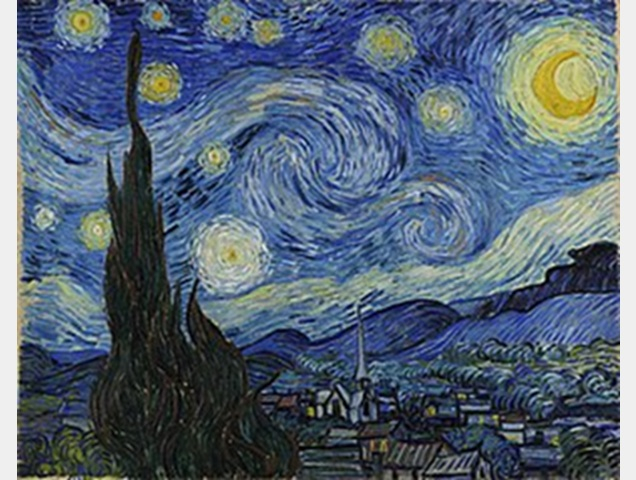Research News
Aug 8, 2025
- Science
Quantum ‘Starry Night’: physicists capture elusive instability and exotic vortices
First direct observation of quantum Kelvin–Helmholtz instability reveals eccentric fractional skyrmions
“The Starry Night” (1889) by Vincent van Gogh
The swirling patterns in Vincent van Gogh’s “The Starry Night” can help us visualize quantum Kelvin-Helmholtz instability (KHI). The central spiral and surrounding stars and moon resemble the vortices formed where two fluids meet. Van Gogh’s iconic crescent may even hint at the crescent-shaped skyrmions seen in quantum KHI.
Credit: Public Domain

Van Gogh’s “The Starry Night” has stirred the souls of art lovers for over a century. Now, its swirling skies may also speak to physicists, as it echoes the patterns of quantum turbulence.
Physicists at Osaka Metropolitan University and the Korea Advanced Institute of Science and Technology have for the first time successfully observed the quantum Kelvin–Helmholtz instability (KHI) — a phenomenon predicted decades ago but never before seen in quantum fluids. The instability produces exotic vortex patterns known as eccentric fractional skyrmions, whose crescent-shaped structures bear a resemblance to the moon in Van Gogh’s masterpiece.
KHI is a classic phenomenon in fluid dynamics, where waves and vortices form at the boundary between two fluids moving at different speeds — as seen in wind-whipped ocean waves, swirling clouds, or Van Gogh’s skies.
“Our research began with a simple question: Can the Kelvin–Helmholtz instability happen in quantum fluids?” said Hiromitsu Takeuchi, an associate professor at Osaka Metropolitan University’s Graduate School of Science, and one of lead authors of this study.
By cooling lithium gases to near absolute zero, the researchers created a multi-component Bose–Einstein condensate — a quantum superfluid — with two streams flowing at different velocities. At their interface, a wavy fingering pattern emerged, mirroring classical turbulence but then vortices are generated, governed by the strange rules of quantum mechanics and topology.
These vortices turned out to be eccentric fractional skyrmions, or EFSs — a newly discovered kind of topological defect.
“Skyrmions are usually symmetrical and centered,” Takeuchi said. “But EFSs have a crescent-like shape and contain embedded singularities — points where the usual spin structure breaks down, creating sharp distortions.”
“To me, the large crescent moon in the upper right corner of ‘The Starry Night’ looks exactly like an EFS,” Takeuchi said.
Skyrmions, first discovered in magnetic materials, are attracting growing interest for use in spintronics and memory devices due to their stability, small size and unusual dynamics. The discovery of a new kind of skyrmion in a superfluid could have implications for both applied technologies and our understanding of quantum systems.
Looking ahead, the team plans to refine their measurements.
“With more precise experiments, we may be able to test 19th-century predictions about the wavelength and frequency of KHI-driven interface waves,” Takeuchi said.
The researchers also see broader theoretical potential.
“EFSs challenge traditional topological classifications,” Takeuchi said. “Their embedded singularities raise new questions, and we hope to explore whether similar structures arise in other multi-component or higher-dimensional systems.”
Funding
National Research Foundation of Korea Grant under Projects No. RS-2023-00207974, RS-2023-00218998, RS-2023-00256050 and 2023M3K5A1094812
Brain Pool Plus Program through the NRF funded by the Ministry of Science and ICT (2020H1D3A2A03099291) and the NRF grant (2021R1C1C1006273)
JST, PRESTO Grant No. JPMJPR23O5
JSPS KAKENHI Grants No. JP18KK0391 and JP20H01842
Paper information
Journal: Nature Physics
Title: Stable singular fractional skyrmion spin texture from the quantum Kelvin–Helmholtz instability
DOI: 10.1038/s41567-025-02982-x
Authors: Seung Jung Huh, Wooyoung Yun, Gabin Yun, Samgyu Hwang, Kiryang Kwon, Junhyeok Hur, Seungho Lee, Hiromitsu Takeuchi, Se Kwon Kim and Jae-yoon Choi
Published: 8 August 2025
URL: https://www.nature.com/articles/s41567-025-02982-x
Contact
Hiromitsu Takeuchi
Graduate School of Science
Email: takeuchi[at]omu.ac.jp
*Please change [at] to @.
SDGs
